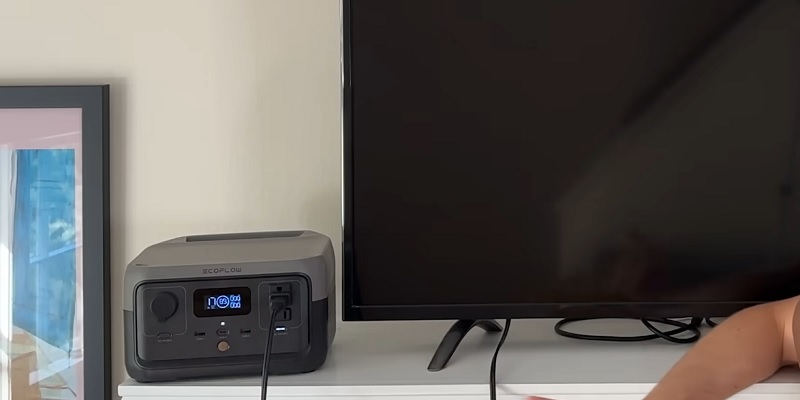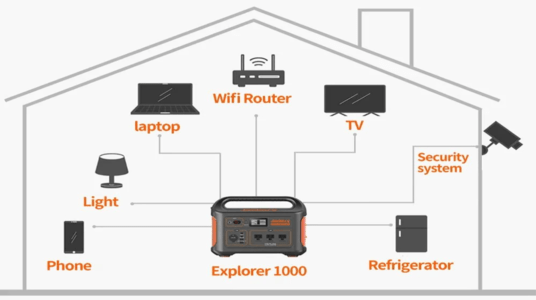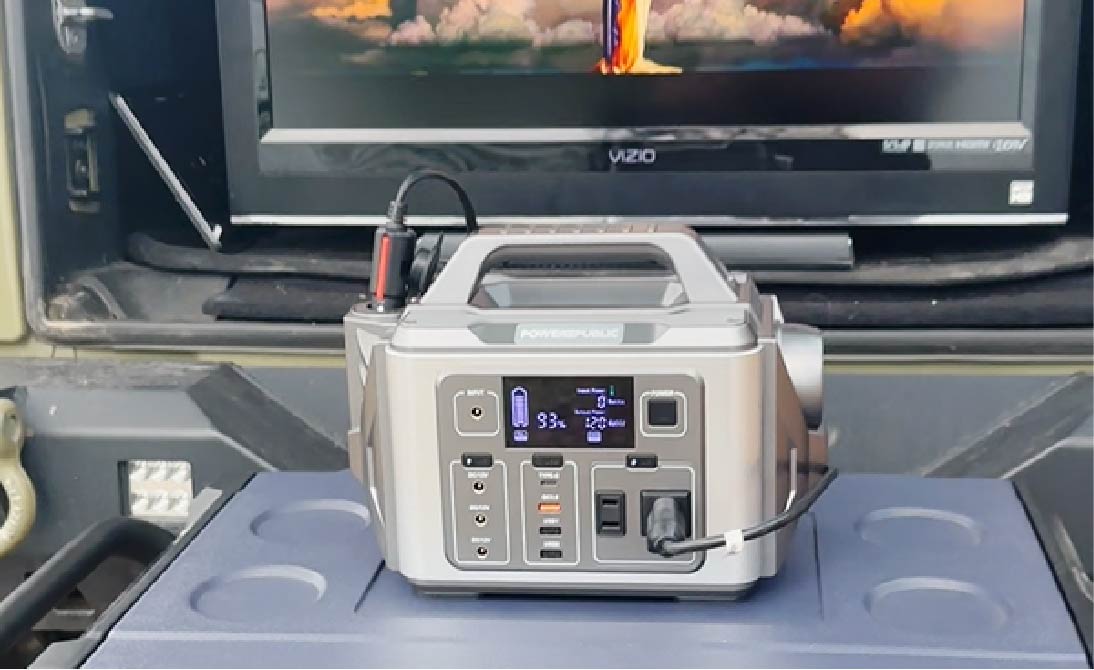Yes, a portable power station can run a TV. The key lies in matching the power station’s output with the TV’s power requirement.
Most modern TVs have relatively low power needs, making them compatible with many portable power stations. Imagine camping under a starlit sky or dealing with a power outage. You might wonder if you can still watch your favorite show. Portable power stations offer an innovative solution for powering devices like TVs away from traditional outlets.
These compact gadgets provide electricity, enabling you to enjoy entertainment even in remote locations. Understanding how they work with TVs is crucial. It involves knowing your TV’s wattage and the power station’s output capacity. So, if you want to keep your TV running during an adventure or emergency, this guide will help you make an informed decision.

Introduction To Portable Power Stations
Portable power stations can indeed run a TV. Most TVs require low to moderate power, making them compatible. Check the TV’s wattage and the power station’s capacity to ensure efficient operation.
Are you tired of power outages interrupting your favorite shows? Or maybe you’re planning a camping trip and want to enjoy some entertainment under the stars. Portable power stations might be the solution you’re looking for. These handy devices have become a game-changer for people who need electricity on the go. Let’s dive into what makes them tick.
Definition And Purpose
Portable power stations are compact, battery-powered devices designed to provide electricity wherever you are. They come equipped with various ports to connect different devices, including your TV. The primary purpose is to offer a reliable power source during emergencies or when you’re far from a traditional outlet.
Imagine having a mini power plant in your backpack. That’s essentially what a portable power station is. It stores electricity and can release it when needed, making it perfect for road trips, camping, or unexpected blackouts at home.
Growing Popularity
These devices are gaining traction for a reason. With the rise in outdoor activities and a growing need for sustainable energy solutions, more people are turning to portable power stations. They’re not just for tech enthusiasts; even the average household is starting to see their value.
Have you noticed more people talking about living off the grid? Portable power stations are a big part of that conversation. They’re easy to use and environmentally friendly, which appeals to a wide range of users.
What could you do with a portable power station in your life? Whether it’s ensuring you’re not left in the dark during a storm or adding a touch of modern convenience to your camping trip, the possibilities are endless.
Understanding Tv Power Requirements
Are you wondering if your portable power station can keep your TV running during a camping trip or a power outage? Understanding TV power requirements is the first step to ensure your entertainment doesn’t get interrupted. Let’s break down the essentials to make sure you’re prepared.
Power Consumption Basics
Every TV has a specific power consumption level, usually measured in watts. This number indicates how much electricity your TV needs to operate. Have you ever checked the label at the back of your TV? It often states the power usage right there.
Most modern TVs use between 50 to 200 watts, depending on their size and type. For example, an LED TV might consume less power than an older LCD model. Knowing these numbers will help you determine if your portable power station can handle the load.
Factors Affecting Tv Power Usage
Several factors can influence how much power your TV uses. The size of the screen is a big one – larger screens generally require more power.
Additionally, the type of display technology matters. Plasma TVs are known for their high power consumption, while LED TVs are more efficient. Do you have your TV settings on maximum brightness? This can also increase energy usage significantly.
Consider how long you plan to watch TV. Continuous use will drain your power station faster. Are you aiming to watch a movie marathon or just catch the evening news? Planning is crucial to ensure you don’t run out of power unexpectedly.
So, what’s your plan for your TV during a power outage or outdoor adventure? Understanding these factors will help you make informed decisions and get the most out of your portable power station. Armed with this knowledge, you’re ready to enjoy your favorite shows anytime, anywhere.
Portable Power Station Capabilities
Have you ever found yourself camping under the stars, only to miss the thrill of your favorite TV show? A portable power station might just be the answer. These handy devices are designed to bring electricity to places where traditional outlets are out of reach. But can they power your TV? Let’s dive into the essentials of portable power station capabilities.
Battery Capacity
Battery capacity is the heart of a portable power station. It determines how long your device can keep running. Measured in watt-hours (Wh), the capacity gives you an idea of how much energy the power station can store.
Imagine a power station with a 500Wh capacity. It can theoretically run a 100W TV for about five hours. But what if you want to watch for longer? Look for a power station with higher capacity or consider conserving power by lowering the TV brightness.
Output Power Rating
Output power rating tells you what devices your power station can handle. This is usually measured in watts (W). If your TV requires 150W, your power station must have an output rating of at least 150W to run it.
Some power stations have multiple output options, like AC outlets or USB ports. These can be useful if you want to charge your phone while watching TV. Always check the power requirements of your TV before heading out on your next adventure.
Portable power stations offer a world of possibilities. They bring comfort to your outdoor experiences. But how do you choose the right one? What features matter most to you? Dive into the world of portable power and discover how it can transform your next adventure.
Matching Power Station To Tv
A portable power station can run a TV efficiently, given its compatibility with the TV’s power requirements. Ensure the power station’s wattage matches or exceeds the TV’s needs for uninterrupted viewing. Battery capacity and output ports also play a crucial role in determining how long and effectively the TV can operate.
Matching a portable power station to your TV can seem tricky. It’s about ensuring the power station meets the TV’s energy needs. You want smooth viewing without interruptions. Let’s explore how to calculate and choose the right power station.
Calculating Power Needs
Start by checking your TV’s power requirements. Most TVs have a label near the power cord. This label shows the wattage needed. Common TVs use between 50 to 400 watts. Knowing this helps in choosing the right power station.
Calculate the total power your TV needs. Multiply the wattage by the hours you plan to use it. This gives you the total watt-hour requirement. A TV that uses 100 watts for 5 hours needs 500 watt-hours.
Consider other devices you might connect. Add their wattage to your calculation. Make sure your power station can handle the total watt-hours.
Choosing The Right Station
Choose a power station with enough capacity. It should meet or exceed your calculated watt-hours. Look for stations with lithium-ion batteries. They are efficient and reliable.
Check the ports available on the power station. Ensure it has the right outlet for your TV plug. Some power stations have multiple outlets. Useful for connecting other devices simultaneously.
Consider the size and weight of the power station. Portable options are easy to move around. Make sure it fits your space and needs.
Extra 5% Off Coupon: 25EFBFAFF
Look at the charging time for the station. Faster charging means less waiting. This is ideal if you plan to use it frequently.
Running A Tv On A Power Station
Portable power stations can indeed run a TV, offering convenience during outdoor adventures or power outages. Check the TV’s wattage to ensure compatibility with the power station’s capacity. This setup provides a flexible solution for enjoying entertainment anywhere.
Running a TV on a power station opens up new possibilities. Imagine watching your favorite show while camping in the wilderness. Or, keeping entertained during a power outage. Portable power stations offer flexibility and independence. They make it easy to enjoy TV anywhere. But how do you set up and monitor your TV on a power station? Let’s dive into the details.
Setup And Connection
Setting up a TV with a portable power station is simple. First, ensure your power station has enough wattage. Check your TV’s power requirements. Most TVs need around 60 to 150 watts. Make sure your power station matches or exceeds this. Next, connect the TV to the power station. Use the correct cable. Most power stations have AC outlets. Plug your TV into the outlet. Turn on the power station. Then switch on your TV. You are ready to watch.
Monitoring Power Usage
Monitoring power usage is crucial. It helps extend the power station’s battery life. Many power stations have display screens. These show how much power is left. Keep an eye on this. Some stations offer mobile apps. These apps provide real-time updates. Check how long your TV can run. Adjust the brightness to save power. Turn off the TV when not in use. This conserves energy. Using a power-efficient TV also helps. Always be aware of power levels. It ensures a smooth viewing experience.

Considerations For Extended Use
Thinking of using a portable power station to run your TV? It’s a smart choice for flexibility and convenience. But, for extended use, there’s more to consider. Key factors include battery life, efficiency, and recharging options. Understanding these can ensure a seamless viewing experience, whether you’re camping or facing a power outage.
Battery Life And Efficiency
Battery life varies by model and usage. Check the power station’s capacity in watt-hours. This tells you how long it can power your TV. Most TVs use 60 to 150 watts per hour. A power station with 500 watt-hours can run a 100-watt TV for about five hours.
Efficiency affects how long your battery lasts. An efficient power station loses less energy during use. Look for models with high efficiency ratings. This ensures more of the battery’s power goes to your TV.
Recharging Options
Recharging options are vital for extended use. Many power stations recharge via AC outlets. Solar panels are another choice, great for outdoor use. They offer a renewable way to keep your power station charged. Some models support car chargers, adding flexibility on the go.
Consider recharging speed. Fast charging means less downtime. Check how long each method takes. A quick recharge can make all the difference during prolonged use.
Read Here: Can You Overcharge a Portable Power Station?
Advantages And Limitations
Portable power stations are handy devices that provide electricity on the go. They can power various gadgets, including TVs. But they come with both advantages and limitations. Understanding these can help you decide if a portable power station is right for your needs.
Portability Benefits
Portable power stations are compact. Easy to transport. You can take them anywhere. Camping trips, outdoor events, or even in the backyard. Their lightweight design makes them user-friendly. No need for complex setup. Just plug and play. This convenience allows watching TV anywhere. Perfect for impromptu movie nights under the stars.
Potential Drawbacks
Despite the benefits, there are limitations. Power stations have limited battery life. Running a TV drains the battery quickly. You may need frequent recharges. Also, not all power stations support high-wattage TVs. Some may only run smaller models. Check your TV’s power requirements first. Price can also be a concern. High-capacity stations are costly. Consider your budget before buying.

Future Of Portable Power Technology
The future of portable power technology is bright and exciting. With rapid advancements, these devices are becoming more efficient and versatile. They are no longer just for emergencies. Portable power stations now power everyday gadgets, including TVs. Let’s explore the innovations and trends shaping this field.
Innovations And Trends
Battery technology is evolving fast. Lithium-ion batteries are lighter and more efficient. Solar charging is now a viable option for many devices. This means you can charge your power station with sunlight. Wireless charging is also gaining popularity. It offers convenience and eliminates tangled cords.
Smart features are becoming standard. Many power stations now have LCD screens. These screens show battery levels and charging status. Some models even connect to smartphones via apps. This allows users to monitor usage and receive alerts.
Extra 5% Off Coupon: 25EFBFAFF
Impact On Daily Life
Portable power stations are changing how we live. They offer freedom from traditional power sources. You can watch TV outdoors or during a power outage. They provide peace of mind during emergencies. Portable power is now accessible to more people.
These devices are also eco-friendly. They reduce reliance on fossil fuels. By using solar energy, they cut down on carbon emissions. This makes them a great choice for the environmentally conscious. Portable power stations are not just for camping trips anymore. They are becoming a part of everyday life.

Frequently Asked Questions
What Size Portable Power Station Do I Need For A Tv?
A portable power station with at least 300-500 watts is ideal for most TVs. Check your TV’s wattage and choose a power station that exceeds it. Consider additional usage needs if you plan to power other devices simultaneously. Ensure the power station is reliable and suitable for your specific TV model.
Can You Run A Tv Off Of A Power Bank?
Yes, it’s possible to run a TV off a power bank. Ensure the power bank has sufficient capacity and output. Check compatibility with the TV’s voltage and wattage requirements. Larger TVs may need more powerful power banks. Always verify connections for safe operation.
Is It Safe To Run A Tv On A Portable Generator?
Yes, it is safe to run a TV on a portable generator. Ensure the generator provides stable voltage and sufficient power. Use a surge protector to prevent electrical damage. Avoid overloading the generator and check compatibility with your TV’s requirements.
Regular maintenance of the generator enhances safety and performance.
How Long Can You Run A Tv On A Jackery?
A Jackery can power a TV for 3-5 hours, depending on the TV’s wattage and Jackery model. Calculate the TV’s wattage and battery capacity to determine runtime. Jackery’s efficient power management ensures optimal performance, but always check the specifications for precise usage details.
Final Thoughts
A portable power station can indeed run a TV. It’s practical for outdoor adventures. Also, useful during power outages. Remember to check the wattage. Ensure your power station matches the TV’s needs. This makes sure your TV runs smoothly. Compact and easy to transport.
No complex setup required. Enjoy entertainment anywhere. A reliable power source. Ideal for camping or road trips. Keep your devices charged and ready. Explore the freedom of portable power. Consider your options carefully. Choose the right power station for your needs.
Stay powered and connected.


